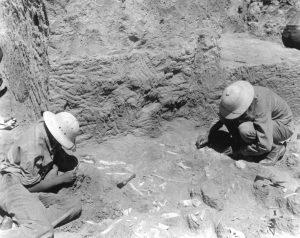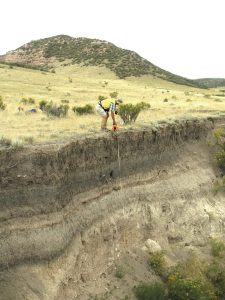In September 1934, Frank Roberts of the Smithsonian Museum and two Fort Collins “relic hunters,” Claude Coffin and his brother Roy, made a discovery 16 miles northwest of Wellington that pushed back the history of mankind in North America 10,000 years to the end of the last Ice Age.
Wisdom at the time insisted Native Americans had only lived on the continent three millennia or so. The Lindenmeier site, named for its Depression-era owners, is still one of the most important archaeological sites in the Western Hemisphere. It is the largest known Folsom-period cultural complex and the thousands of artifacts found there helped flesh out understanding of the lives and commerce of a culture that stretched from the Dakotas to Texas.

In October 2014, the City of Fort Collins and the city’s Museum of Discovery, with the help of eager volunteers, will celebrate the 80th anniversary of archaeological discovery with a series of public programs and a unique symposium. The symposium theme will be “Ancient Lives, Ancient Dreams.” The city will fly Ed Wilmsen to Colorado from Scotland as keynote speaker. Wilmsen wrote an important summary of the excavations: “Lindenmeier, 1934-1974,” as part of his doctorate work. Others who played significant roles in unraveling the secrets of Lindenmeier appear eager to contribute and visit the site again.
Public events at Soapstone Prairie Natural Area, which includes the Lindenmeier site, will include the reconstruction of a 1930s era field tent, and talks and demonstrations by the city’s cadre of Master Naturalists. The Museum of Discovery will display many artifacts from the site and produce a movie for their dome theatre. Colorado State archaeologist, Jason LaBelle, and his students will also contribute in some fashion. LaBelle led a post-symposium survey of the Lindenmeier valley in 2007, after Fort Collins purchased the site. He notes that Lindenmeier is unique because of its size, but there are more than 300 other archaeological sites on Soapstone Prairie and Red Mountain Natural Areas alone. Thousands of sites statewide reveal glimpses of life here over the past 13,000 years.
Scientists reburied the trenches they made at Lindenmeier when they left, but visitors can see the arroyo in which they worked and explore interpretive materials at an overlook a few miles from the entrance to Soapstone. The surrounding prairie looks much as it did during a brief homesteading period that lasted for a few decades near the turn of the 20th century. Cattle grazing companies preserved it as a place where deer, pronghorn and livestock roamed.
Fort Collins sometimes struggles between its mandate to inform and share the site with the public and the problems that ensue when that use leads to trespass and vandalism by modern day “relic hunters” more interested in the monetary value of artifacts than their scientific worth. Zoe Whyman, Community Relations Manager with the Natural Areas Department, thinks the city has “found a good balance so far. What we try to avoid is discussing the artifacts separate from the human story.”
Lindenmeier is unique because it tells prehistoric human stories in unusual detail. People hunted here, yes. Scientist, author and then graduate student Loren Eiseley found a Folsom point embedded in the vertebra of the now extinct Bison antiquus in 1935 that proved beyond doubt that humans felled this extinct Ice Age animal. (See North Forty News, June 2009: “Loren Eiseley and the Ghosts of Lindenmeier.”) But the excavations also revealed beads, tools and carved pieces of ivory that showed that Lindenmeier served as a vital center of art and commerce in the ancient West. A rich bounty of ice age animals also left their bones in this land once enriched by glacial melt-water and a wetter climate.
Citizen volunteers called Master Naturalists tell many of Lindenmeier’s stories at Soapstone. These volunteers take six weeks of training in natural history and educational techniques and engage with school children and adults in various natural areas acquired by the city with the help of a sales tax passed some years ago. I joined the program 18 years ago and was thrilled with the acquisition of Soapstone, as I had known about Lindenmeier since the ’70s and had been a long-time admirer of Eiseley, the master prose writer.

Key advocate
Brian Carroll, another Master Naturalist (and retired 37-year veteran of the FBI), has been a key advocate for the Lindenmeier 80th anniversary celebration. His wife’s long-time interest in archaeology sparked Carroll’s interest in the area. Carroll now serves as a consultant in vulnerability assessments, drawing on his FBI experience, and did some work with the city assessing Soapstone’s security weaknesses. He would like to see the city do more in the way of posting “out of bounds” areas and providing stiff fines for trespassers, but also wants to sing the praises of the site and share the incredible history there. He and Suzy Riding, a city employee who serves as a gatekeeper at Soapstone, have spent considerable time and energy researching the homestead era on the northern prairie.
Carroll located Wilmsen in Scotland and invited him to keynote the proposed symposium. Wilmsen was happy to oblige.
During a move of Lindenmeier artifacts from the Bureau of American Ethnology to the Smithsonian, researchers made an incredible discovery. “Everyone was surprised to find that almost all the boxes of excavated materials from the site had never been opened,” Wilmsen said. Roberts’ published work had been based on the first two field seasons. After 1935, the events leading to World War II intervened. Wilmsen was asked to complete Robert’s work, which he did with National Science Foundation support.
My literary hero, Loren Eiseley, who made the “smoking gun” discovery of Folsom point in bison vertebra, later expressed some reservations about the discoveries at Lindenmeier. In his poem “Flight 857” about his work there he said:
“I know now
it should never have been resurrected
any more than these wheels and wings and electronic voices
should ever again be lifted
from oblivion”
But Wilmsen, though also a fan of Eiseley, observed that “like many in the 60s, Eiseley slipped into a kind of willful innocence, almost a nescience” He goes on to say, “Science does not have a need to know, but people do; and it is part of the importance of archaeology and anthropology that they strive to make the accumulated legacy of all cultures relevant to present descendants of those cultures in equal measures.”
If you have that “need to know,” look forward to the events planned for 2014 at the Soapstone Natural Area. Details will follow in the North Forty News.
Support Northern Colorado Journalism
Show your support for North Forty News by helping us produce more content. It's a kind and simple gesture that will help us continue to bring more content to you.
BONUS - Donors get a link in their receipt to sign up for our once-per-week instant text messaging alert. Get your e-copy of North Forty News the moment it is released!
Click to Donate

